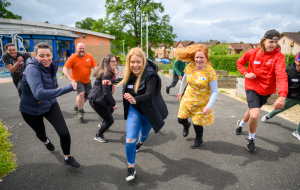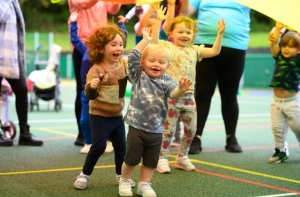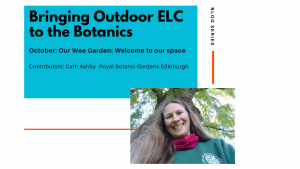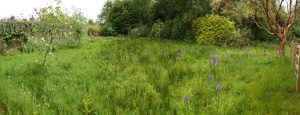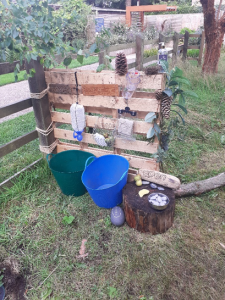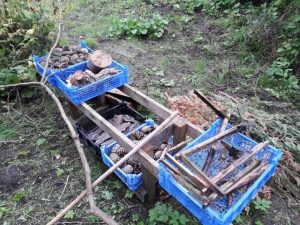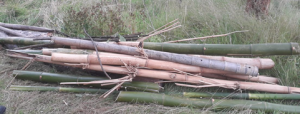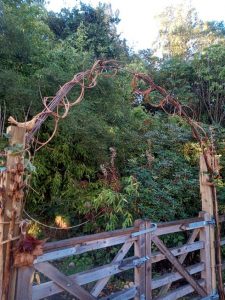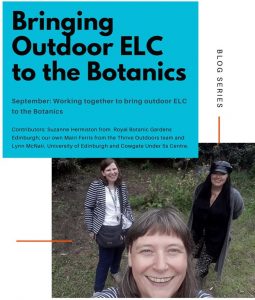Could Active Play be the route to better health?
Being physically active is one of the most important things people can do to improve their physical and mental health. It can help prevent a range of non-communicable diseases, those associated with unhealthy behaviour such as cardiovascular disease and diabetes, and improves mental health and cognitive functioning, among other benefits.
However, the new Step Up! Tackling the Burden of Insufficient Physical Activity in Europe report from OECD and The World Health Organisation (WHO) tells us that, too many Europeans are physically inactive. One in three European adults do not meet the WHO physical activity guidelines, and almost half never exercise or play sport. The report describes patterns and trends of insufficient physical activity in Europe. It reviews the detrimental impact that current physical inactivity levels have on population health and health expenditure. The report also provides a range of options to address insufficient physical activity, drawing on case studies from across Europe.
Here in Scotland, the 2021 Active healthy kids Scotland Report Card tells us that children living in areas of deprivation aren’t physically active enough with only 13% meeting physical activity guidelines.
Through our own research through the Thrive Outdoors fund, we know physical literacy skills in children are not well developed which is having lifelong consequences for children’s physical and mental health. But there’s another problem…many adults responsible for children don’t understand the importance of physical activity for children or how active play can help. They lack knowledge about the importance of physical literacy and need training and support to facilitate fun and inclusive active play confidently.
So, how do we fix this?
The Active Play programme has been conceived to address problems related to low levels of physical activity during childhood that lead to a range of preventable mental, physical and social problems. It has been developed through a unique third sector partnership that has brought together a range of expertise in outdoor play, physical activity, policy, funding, training, research, and evaluation. Ongoing evaluation and research, undertaken by universities of Strathclyde and Glasgow, alongside our own learning have shown consistent outcomes in these critical areas of health, wellbeing, and development.
Since 2016, 6009 children have taken part in active play 2381 sessions across 162 Glasgow City Council primary schools, early years establishments and community setting. 1049 Primary 5 and 6 children have gone on to become play champions in their school with 50% achieving their Hi5Awards, a nationally recognised SCQF certificate. In 2022 Active Play has extended into the Highlands and has supported 370 children across 3 primary schools, early years settings and communities.
Most importantly, it has contributed to improving attainment, physical health, emotional well-being, and resilience. Teaching staff recognise the benefits with many continuing to deliver Active Play after the programme has ended. Physical activity and literacy levels are enhanced in schools with 80% participating in more active play at breaks and lunchtime, or at home and 74% children taking up/planning to take up new sports clubs or activities after school.
Actify’s Active Play training and support helps to embed a legacy of Active Play within organisations. This training helps to develop the skills and confidence of adults working with children supporting 258 play practitioners, teachers, support for learning workers (SFLW), active schools coordinators and modern apprentices in 2022. Actify’s online platform www.activeplay.org.uk houses many resources including videos, modules, information, and links to research as well as hints, tips, and explanations on how to deliver active play sessions.
“Active Play is one of the most natural ways to target low levels of physical activity. Supporting and enabling adults to facilitate Active Play in nurseries, schools, community groups and at home is vital to change behaviours and encourage a habit of physical activity” Actify
“The Active Play Programme has helped me notice what the wee man is able to do, he was having such a laugh, it made me want to join in more often with him” Parent
“My understanding and confidence have grown delivering Active Play sessions and I will continue to deliver these sessions now that I am more confident. Children are more engaged, willing and focused due to the physical activities. The children’s confidence has grown, and inclusion is more visual. Active Play is a fantastic resource for children and staff.” Early Years Practitioner
How to get involved
Active Play is good for children’s health and happiness. It is essential and a right that our children have access to good quality active play opportunities. We know that children are playing outside less with their friends, playing alone more and are less active than they were before the pandemic.
We have the power to change this.
The Children’s Parliament ‘Schools on the Move Report’ explores the physical and social barriers to children’s engagement in physical activity and sets our 10 calls to action from children. One such call recognises that adults play an important role in ensuring children get enough physical activity. Children want adults at home, at school and in our communities to be encouraging and supportive towards them and to set an example for them by being active themselves and where possible being physically active with their children. Adults can equally benefit. As a parent myself seeing my child healthy and happy, and when appropriate joining in on her active play also has a positive effect for my own health and happiness.
If we believe in a child’s right to play and want to create a better future for all our children, we must continue to ensure more and better active play across all places and spaces becomes a fundamental part of growing up in Scotland.
To find out more click here.
Melodie Crumlin
Thrive Outdoors Fund Manager
Empowering women and girls through Active Play
To mark this year’s Scottish Women and Girls Sports week we want to highlight the positive impact of women and girls’ participation in sports and physical activity through the Active Play Programme. Using a partnership approach it is enabling children, and adults, to participate in, and in turn lead on Active Play across Glasgow and the rural Highlands.
It is clear that taking part in outdoor play, regular sports, or physical activity is good for individuals and communities.
However, despite this, nearly 60% of girls don’t meet the recommended exercise guidelines. Research from Women in Sport shows that at the age of nine, many girls have already been put off sport and over 40% of girls have dropped out of all sports activity by the time they reach their teenage years. We must change this.
We believe that Active Play can be part of the solution to this national problem.
Active Play combines grassroots delivery of inclusive active play, with training and support, so that children have access to more fun and inclusive active play and adults can understand the principles of Active Play and be confident in implementing it. The more adults who are able to continue to facilitate active play, the more active play for children.
Since 2016 Inspiring Scotland has have worked in partnership with Glasgow City Council to deliver Active Play to 5,000 children in 147 primary schools and this year will bring the programme to the Highlands in 3 primary schools, benefitting around 360 children.
Active Play is typically delivered over a 15-week period for 1 hour per week with 30 mins of structured active play led by a trained charity leader and 30 mins of outdoor free play activity. The sessions can take place in a school, nursery, or community setting. And the approach is underpinned by three drivers: Fun, Active and Inclusive.
Bringing the fun back into physical activity can be a huge incentive for engaging women and girls in sport. The team of partners collaborating on the programme also understand the importance of involving the children, and those who care for them in a way that promotes confidence, leadership, and ownership – boosting motivation and physical competence.
The Active Play programme is backed by evidence from a PHD doctorate, internal and external evaluations. We know it is building children’s resilience, confidence, and self-esteem. Data has also shown children have improved relationships, physical ability, negotiating skills, energy levels/stamina, confidence, and happiness all being improved.
Teaching staff are also recognising the benefits with many continuing to deliver Active Play after the programme has ended. Feedback has also suggested that physical activity/literacy levels have been further enhanced by 74% children taking up/planning to take up new sports clubs or activities after school. In addition to 80% participating in more active play at breaks and lunchtime, or at home.
The Value of Partnerships
The Active Play programme would not be possible without the expertise, knowledge, and resource from a range of partners.
Actify lead on the CPD training of all adults involved in the programme and provide a centralised place for learning and sharing of best practice. Check out the Active Play hub here: https://actify.org.uk/activeplay
Having professional play experts leading Active Play on a weekly basis is crucial to the success of the programme. These positive and trusted role models bring their expertise, cooperative working practices and shared learning and is enhanced by the ongoing CPD delivered by Actify. Additionally, the play charities provide a bridge between communities/families and schools; providing wraparound support to the most vulnerable children across Glasgow.
Inspiring Scotland’s role has been central to the ongoing strategic development of Active Play. From inception to now, working closely with Glasgow City Council Education Department, PEPASS, teachers, schools, and other stakeholders across the country and the grassroots charities to ensure a joined up and complementary approach.
If we value the health and well-being of girls, and all children and want to create a future of young people and adults who enjoy being physically active then we must continue to work together to remove barriers. We can provide more and better active play, physical activity and sporting opportunities which are fun, active, and inclusive and become a fundamental part of growing up in Scotland.
 For more information on the Active Play programme please feel free to drop me a line Melodie Crumlin, Thrive Outdoors Fund Manager melodie@inspiringscotland.org.uk or follow on Twitter @Melodie_Crumlin
For more information on the Active Play programme please feel free to drop me a line Melodie Crumlin, Thrive Outdoors Fund Manager melodie@inspiringscotland.org.uk or follow on Twitter @Melodie_Crumlin
Thrive Outdoors Blog Series: ‘Our wee garden’
Blog 2
Read on as we share Blog 2 in our blog series on bringing Outdoor ELC to the Botanics in Edinburgh. This week’s blog contributor is Cath Ashby part of the learning team at the Royal Botanic Gardens Edinburgh.
Hi I am Cath Ashby and I have worked at the Botanics for 23 years first as a horticulturist and for the past 16 in the Learning Team working with schools pupils of all ages.
During this time, I have seen the challenges and pleasures of sparking wonder about plants in children who often arrive thinking that a garden is boring and instead wishing they were visiting the cuddly (or not so cuddly) animals in the Zoo. ‘Plant blindness’ is an often talked-about phenomenon in research circles and basically humans are more wired to notice moving things with faces like ourselves (our survival as a species depended on it).
But research also shows that green spaces are beneficial to our health and wellbeing, we just need to slow down enough to notice and connect! If we, as outdoor educators, manage to encourage this, the magic of plants and nature does the rest and children often leave saying being in the garden has been the best thing they’ve ever experienced.
Our Wee Space
Our outdoor nursery space started as a meadow and photos from May show a wild untouched area where native plants flourished alongside remnants of past curators’ gardens when the visitor welcome East Gate Lodge was a home. It has some mature fruit trees and also some gorgeous specimen trees like the paperbark maple (Acer griseum) and the candyfloss tree (Cercidophyllum japonicum) which is named after its heart-shaped leaves that smell of burnt sugar in autumn when they turn from bronze to yellow to orange and pink.
We chose the name ‘Our wee garden’ as it gives a sense of ownership to the children and I almost imagine the larger garden encircling and protecting and nurturing the smaller space and the growth of the children within. This space has a different feel and different rules and is theirs to really explore and love, then over time this love can hopefully spill out as they explore the garden and the natural world outside our gates.
Let’s take a look at the transformation that our education, horticulture and maintenance team have been part of.
First the shoulder high grass was strimmed and cut with a mulch mower that can cope with more uneven ground and longer grass. This was the first time we could see the bare bones of the site. It is quite enclosed and sheltered with a steep bank on the west side and a tall stone wall with climbers on the east.
After the mow we were surprised by the large number of frogs of every size – so many that we could hardly walk for fear of stepping on the tiny froglets. A black and white cat is a regular visitor from the wall shared with the houses, badgers and foxes pass through and the peaceful mornings are full of birdsong.
Key learnings
The Gardens team have learned loads about this space and what it would take to be ‘play friendly’ and we will keep on learning.
We did a survey of plants present noting any sensory plants and toxic species, such as the yew, or other health and safety issues. One common meadow plant grows on site – the native smaller hogweed (Heracleum sphondylium) which shares the properties of the non-native giant hogweed for inducing potential skin blistering and rashes when sap on the skin reacts with sunlight. We regularly scan the site to dig out the plants, but strong branching roots mean this will keep popping up.
Rushes growing meant that there would be wet areas and as time has gone on, after a very dry summer, we now find ourselves finding creative solutions to deal with boggy areas. This pilot gives us a chance to see how a new site that isn’t under tree canopy copes with lots of tiny feet through the winter in increasingly wetter weather due to climate change. The site will continue to evolve.
We have a shed and a pop-up toilet, handwashing stations and fluid activity areas that encourage independent play and exploration.
Using nature’s materials!
Whenever our arboriculture team have been cutting down diseased trees we have been given some wonderful large logs and tree rounds. Many of this team have young children and have helped us by saving treasures and imagining how their children would love to play on them and with them. Of course, they are living the dream career for children who love climbing trees!
We have giant bamboo from the glasshouses, big pebbles and have been scouring areas for anything that is being thrown out or recycled around the organisation like office inbox trays, old slide boxes, offcuts of wood and old metal buckets.
Caroline, our wonderful creative early years practitioner has eagle eyes!
She has also made some fabulous decorative items, like a weather board and a welcome archway entrance hung with willow wreathes and leaf bundles made by the children.
We really are lucky to be part of an organisation where we have access to abundant natural and other materials like pallets and old slabs. We are aiming to be as sustainable as possible repurposing and reusing items.
Sharing Spaces: What do RGBE staff think?
There has been much negotiation to get to this pilot stage with input from staff across the RBGE team. We will continue to see how things develop and to see what staff think of the idea of an outdoor nursery in a botanic garden over time.
Many staff members that have come to the site have wistfully wanted to stay and play from the most serious scientist to our own education staff. One horticulture team member recently witnessed the interaction of the children on the site and told me that
‘The kids look like they love it…all the children were engaged with the space, there was not one bored child there.”
They were all interested and had found something to do.
I asked them:
‘Do you think you would have enjoyed it as a child?’
They said:
‘Probably, I didn’t mind getting dirty and messing around outside.’
This made me reflect on whether that is a potential far-reaching impact of projects like this. Will children who see getting ‘dirty’ and being in contact with soil and mud, weather and plants as normal, be more likely to consider careers like horticulture? I certainly was that child!
Through gardening with primary children, I have observed some who are fearful of and hate getting dirty hands. Does some of this stem from never being exposed to experiences like outdoor nurseries and forest schools when younger which are relatively new approaches?
So, the site is developing into its own character – being something between a forest school space and the rest of the more cultivated garden. Just now it resembles a mud monster in places which we are tackling, but it is really special and children (and grown-ups) love it. There really are fairies at the bottom of the garden too!
Enjoy this blog? Then keep an eye for the next blog coming on Friday the 19th of November ,where both the up’s and downs of piloting a new outdoor ELC in a botanical garden will be shared as well as the key learnings along the way!
Join in the conversation, add your pictures, or just chat with us at:
- Facebook @ThriveOutdoorsScot,
- Twitter @Thrive_Outdoors
- Instagram @thrive_outdoors
- or by email to amy@inspiringscotland.org.uk
| Useful Links |
| https://www.bbc.com/future/article/20190425-plant-blindness-what-we-lose-with-nature-deficit-disorder |
Thrive Outdoors Blog Series: Bringing Outdoor ELC to the Botanics
Blog 1
This week sees the start of an exciting collaboration between the Royal Botanic Garden Edinburgh (RBGE), Inspiring Scotland’s Thrive Outdoors team, the University of Edinburgh and two Edinburgh-based Early Learning and Childcare settings; Edzell Nursery and Outdoor Nursery Edinburgh (ONE).
Over the next six months the partners will undertake research as groups of children from the nurseries experience outdoor play and learning in a unique setting.
Is it possible to have an outdoor Early Learning and Childcare setting within a botanical garden?
That is the main question that RBGE want to discover the answer to and what the parallel research, run by University of Edinburgh and Inspiring Scotland, will explore.
Each month, the Thrive Outdoors blog series will feature this project from a range of perspectives.
First up in this exciting series is a conversational blog between Suzanne Hermiston from RBGE; our own Mairi Ferris from the Thrive Outdoors team and Lynn McNair, University of Edinburgh, Cowgate Under 5s Centre and Thrive Outdoors Associate as they met onsite for the first time.
What is the inspiration and motivation for you in establishing this project at the Royal Botanic Gardens in Edinburgh?
Suzanne: “During lockdown we became increasingly aware of the importance of children playing outdoors and reconnecting with nature. This, combined with the Scottish
Government’s increased commitment to childcare provision, meant it was the perfect time to consider how the Botanics could best encourage the next generation of horticulturists and botanists. RBGE hosts the national collection and it’s essential that we secure the future of that collection by supporting the next generation in exploring it in it’s full glory. Many people already enjoy the garden as a family, but we wanted to allow children to see beyond the simple joy of being in a green space and increasing their knowledge of plants and their impact on our planet. Recent events such as flooding and forest fires internationally, have raised awareness of the challenges of biodiversity loss and the climate emergency, but it’s our responsibility at RBGE to guide children from as early as possible to help them see how their individual actions can make a positive difference.”
Mairi: “For me, the joy of this project is the collaboration and connection of all the partners, it really feels like the perfect demonstration of the National Position Statement on Outdoor Play and Learning in action!
Scotland’s National Position Statement on Outdoor Play and Learning states:
We commit to life-enhancing outdoor play and learning for all of Scotland’s children and young people by:
- Widening access to the high-quality, diverse greenspaces and natural landscapes that exist throughout all our communities to ensure that all children, young people and families have easy, local access to excellent outdoor
- Opening up more of our communal and publicly-managed spaces for playing and learning outdoors, ensuring that children and young people know they are entitled to access these spaces and feel safe and comfortable using
- Enhancing and enriching urban greenspace and built environments to be inviting, play- friendly places, offering easy access to the outdoors and nature close to home.
- Empowering every adult involved in the lives of our children and young people with the confidence, enthusiasm and skills to encourage and support them to play and learn
- Generating and sharing knowledge and evidence-based research to promote better understanding of the benefits of playing and learning
As founder signatories of the Statement, Inspiring Scotland is excited to be part of a project which is aimed at investigating ways to ensure children have access to high quality care and learning experiences within an urban greenspace, which is not traditionally thought of as a space for children’s exploration.”
Lynn: “I am really interested in being part of this project as it first of all meets with my research interests around early childhood and children in nature. Furthermore it is an exciting, innovative venture that opens up the potential for children to be horticulturalists of the future. This project is not simply exploring whether children will play in the space, as we know they will do that, it also invites us to consider the affordances and knowledge enhancement of nature.”
Why is the research element important?
Suzanne: “RBGE is a research focused organisation, with members of our Science team working globally to carry out research and vital conservation work. It seemed logical, therefore, that our consideration of the benefits of an outdoor nursery within a botanical garden should follow the same – evidence based – approach. We’re also keen to ensure that whatever we learn from the pilot is captured and shared with others, whether that be other botanical gardens considering a similar project or highlighting the value of botanical gardens to nurseries across the UK and early years practitioners. Whatever the outcome, we hope this will be a rich source of learning for so many. Working in partnership with Inspiring Scotland and the University of Edinburgh, brings all the necessary components together to ensure the work we do is supported through best practice guidelines and cutting edge pedagogical research.
Lynn: “The primacy of this research is that it will be ethnographic as the researchers intend to live alongside the children in the everyday lives as they construct and make sense of their surroundings. The children’s behaviour will be studied within the context of the RGB site. In ethnographic research, the data is gathered primarily through observation and informal dialogue with the children (and adults working with the children). As this form of research is relatively unstructured, the researchers will capture raw / fluid data which will be analysed and interpreted for meaning.”
And what of the space?
Mairi: “Initially, although very excited by the prospect of the project, I admit I was sceptical about how children could get a high quality meaningful, child-led, experience here at the Botanics. Would there be echoes of ‘No!’ and ‘You can’t go there!’ ringing round the gardens?!
The tension between providing access to children as citizens whilst protecting the precious plant collection has been carefully thought through by the Garden team and a dedicated space has been created as the children’s base.”
Suzanne: “Identifying an appropriate space within the garden for the nursery was definitely challenging. Our original plans put the children right in the heart of the garden, but by observing the children during six exploratory visits, where different groups of 5 or 6 children visited for one afternoon each, we quickly realised that this location would not provide an opportunity for the child led approach we hoped to cultivate. Sitting within the national collection didn’t allow for ‘free exploration’ without having to limit enquiring minds. Rather than the whole experience being based on what the children couldn’t do, we wanted to start by allowing them to build a relationship with the garden with fewer limitations, whilst we worked with them to help them understand the difference between an open forest space and a protected botanical garden. In this way we hope that they will soon learn to identify the difference between the two spaces, whilst equally enjoying and respecting both. The new site, was previously unused and provides a perfect space to do so. It also offers the added advantage of being close to the Garden of Tranquillity (used by dementia groups and care homes), which we hope may allow for intergenerational learning opportunities as the project progresses. The new site – now named “our wee garden” – offers the perfect mix of rugged landscape, muddy sections and beautiful mature trees which form an amazing canopy for protection from the elements (not to mention being perfect for our mini explorers to create their own dens and look for fairies!).”
Lynn: “On my way to the RBGE site I had pictured in my mind a cultured garden environment. However, the moment Suzanne introduced me to the site I was stunned by its beauty and its immense potentialities. I have always had a deep interest in the planetary ecosystem and indeed, I am, a sentimental nature lover; and the site offers opportunities for children (my greatest love) to explore and be in nature. The space is magical, with mature trees, where children will, I have no doubt, explore the nooks and imaginative spaces; there are mud piles, where children can delve into this rich natural resource…there are quiet spaces, for contemplative thought. In the background alongside the birds and insects you can hear the trickle of water…in truth, after a very busy day, I did not want to leave this beautiful space…I am extremely excited to begin our research in order to discover how the children make meaning of this magical space.”
Stay tuned as we continue this blog series sharing the next part of this exciting journey on Friday the 15th of October!
Enjoy this blog? Then keep an eye for the next blog in this series where both the up’s and downs of piloting a new outdoor ELC in a botanical garden will be shared as well as the key learnings along the way!
Join in the conversation, add your pictures, or just chat with us at:
- Facebook @ThriveOutdoorsScot
- Twitter @Thrive_Outdoors
- Instagram @thrive_outdoors
- or by email to amy@inspiringscotland.org.uk
| Useful Links |
|
Nurturing the ‘new normal’ through outdoor learning and play
As we move out of lockdown, embracing our outside spaces can help society recover and build resilience for the future, writes Thrive Outdoors Programme Manager Rachel Cowper.
The online algorithms must be getting to know my reading habits of late, because I have come across many articles over the last few days discussing what the ‘new normal’ will be.
These include pieces and papers from Public Health Scotland to The Guardian, from George Monbiot to Scottish Government – even from external Infrastructure Property Agencies – many of which I have also had the privilege of being involved with or have contributed to.
The common thread running through them all is the notion that what has worked before will not work the same way in the future. One notable example is the Scottish Government’s Covid-19 Framework for Decision Making document, which sets out the challenges we face transitioning out of lockdown. As one passage on adjusting to the ‘new normal’ notes:
Before this crisis we were focussed on our mission of making Scotland a greener, fairer, and more prosperous country and this has not changed. But the place from where we are starting has.
In other words, despite the last few extraordinary months, our needs as humans remain the same. So, consider this: what do we really need to do to feed, educate and employ people in our society? And is there the opportunity to support the ‘new normal’ through innovative decision-making and building on the sense of collaboration and community that has developed?
Building on unintended consequences
At a time when much media is focussed on children, particularly when they go back to school and what this might look like, could it be time to think instead about the unintended consequences of lockdown, and build on the positive potential?
A prime case in point from a health perspective is obesity – an issue often exacerbated by sedentary behaviours and poor diet. Yet during lockdown, we have become used to seeing people out walking and engaging in their local communities. Could it be that when people are denied access to something that is ‘taken for granted’, its true value becomes clear?
If this collective desire to get outside means that increased value is being placed on outdoor time, could this be embraced to enhance learning and play opportunities for our children? Might it be used to aid health and wellbeing, and provide the space to help with recovery and resilience?
Coming out of lockdown and embracing the outdoors
Outdoor educators know that you do not need four walls to teach children. Rather, you need passionate, knowledgeable, enthusiastic teachers and leaders. You only need look at the volumes of research available, much of which is summarised in Scotland’s national position statement on outdoor play and learning.
As we move out of lockdown, the use of the outdoors at schools can provide space for social distancing and opportunities for learning. Moving more can address sedentary behaviours and improve physical health. Outdoor and natural spaces benefit our mental health, particularly salient as we mark Mental Health Awareness Week. These are surely things we all want while we look to recover as a society and build resilience for the future.
If there is an emerging acceptance that what has worked in the past will not necessarily be good for the future, then now is the time to decide whether we need to return to the ‘old normal’. Clearly, where outdoor spaces are concerned, the ‘new normal’ has the potential to be so much better.
Playing outside helps children to have a stake in their communities
By Jill Fraser, Community Play Performance Advisor
Community is an old and deeply human idea. It is about sharing; people sharing experiences, sharing places and sharing hopes. We gain a sense of community early in our lives. For children, playing is intrinsically linked to a burgeoning sense of belonging to a bigger group of people and a place. Through play, children share experiences and emotions and build a community with friends. They explore the spaces in which they play and understand how to share them.
When children play and share joy in their physical neighbourhood spaces, they get their first experience of community in the wider sense too. Playing outdoors in a shared community space, whether a small patch of grass, a street, or a play park, allows children to connect with their local areas. It’s also a chance to interact with a broader group of people than in school or at home, meaning opportunities for intergenerational activity and enhancing community cohesion.
Children develop a sense of place and feeling of belonging, ownership and inclusion with the place they are growing up. Because local kids are out playing and having fun in their local spaces and can be seen doing so, the wider community benefits from a positive sense of itself as a safe and happy place. Playing outside really is that powerful a tool.
But too many children in Scotland lack the chance to play regularly outside in their communities and opportunities are reduced further for children in deprived areas.
Our Play Rangers model of community play is designed to change that. Play Rangers are professional playworkers who run open access play sessions within a community using open spaces in neighbourhoods close to where children live. They encourage children to attend the free sessions and support parents and carers who may not be able to take their children out or are not comfortable with their children playing out.
It also combats antisocial behaviour, helps build relationships within neighbourhoods and improves children’s self-esteem, social skills and health. It helps bring about lasting improvements to the quality of children’s play, the use of local open spaces and the way communities come together.
We need communities to come together in this way. Children’s play spaces should be an important part of community life as children who play are healthier and more resilient than those who don’t. We need to work together to make spaces safe and accessible for children’s play, to make sure they’re well cared for and free from litter, vandalism, dog mess, crime and antisocial behaviour.
Through our work with the charities who lead Play Rangers activity, we have seen these improvements in action. As children become more visible in their communities and residents become aware that local spaces are used by children for playing, these spaces tend to become better looked after with less dog fouling or antisocial behaviour.
Being increasingly visible also helps children feel more a part of their community. By supporting and empowering children to reclaim their streets and outdoor spaces, their voices become heard and they feel listened to and valued. And including them in decision making helps break down generational barriers and give them a feeling of control over changes and a greater sense of ownership of their place. Some children who attend Play Rangers sessions now undertake ‘poo patrols’ to highlight areas of dog mess and educate residents about dog fouling.
Giving children a voice and an increased feeling of control over their local area helps them to feel more involved in their community and provides a sense of identity and shared purpose. It is this sense of identity and shared purpose that will enable us to build stronger, more engaged communities for the future.
Find out more about Play Rangers
Beyond play: community play charities are a vital support for struggling families
By Jill Fraser, Community Play Performance Advisor
Inspiring Scotland exists to address poverty and disadvantage. The role of Play Rangers, our community play programme, in this work isn’t self-evident. Yet giving children the opportunity to play outside, in their own neighbourhood, can reveal the damaging effects and true extent of child poverty in Scotland and help families access the support they need.
All our outdoor play programmes aim to address inequality and improve the life chances of Scotland’s children, and their families, by supporting charities to give kids the chance to reap the benefits of play. Working with these charities in community settings and hearing about the experiences of the children they support has been sobering. What they do and see goes way beyond ‘just’ play.
Child poverty is mentioned again and again. The charities we work with believe numbers are increasing. Hunger and lack of food are common. Children who are hungry don’t have the energy to play. As a result, food is now offered at many play sessions. During the recent October holidays, feedback from play workers indicated the snacks provided at these sessions were often the only meal some children had that day.
Lack of appropriate clothing is also an issue. Some children are not allowed out to play ‘in case they get their clothes dirty’. Even for those who do have more clothes, laundry costs can be a worry for parents. And in extreme cases, children are being kept off school on ‘dress down’ Fridays because they don’t have alternative clothing beyond the school uniform. As we move into winter, some children don’t have warm enough jackets to go outside, others don’t have jackets at all. Some can’t play outside because their shoes are too small, and they can’t run around because their feet hurt.
In addition, community play workers have observed that because of poverty and the stress it places on families, many children are facing challenging and chaotic home lives. Some children are struggling to self-regulate and are showing aggressive behaviour because of insecure home lives. And sadly, some children have said that they prefer to be at school rather than at home because they feel safer there.
Importantly, getting to play outside and make neighbourhood friends is a chance for children to be children; to smile and laugh and have fun. No child should go without food, clothing, friendship, comfort and safety. And no child should go without the chance to have fun. It is a right, not a privilege.
Investing in and valuing the chance to play outside in community spaces is essential. But it’s not ‘just’ play. In providing children with free play opportunities charities are seeing things would not necessarily be visible otherwise. They are able to bring vulnerable children and their families into a community support network. Play organisations themselves are often trusted in the local community and while play cannot solve the problems of poverty, it is increasingly a vehicle to provide access to other support and services that are desperately needed by many families.
The charities we work with are passionate about the work they’re doing and more often than not that work stretches way beyond play. By supporting these essential organisations and helping them to grow stronger we can help to deliver services to those most in need, building valuable networks of support, fostering a sense of community and helping to alleviate poverty and disadvantage among those most deeply affected.
Find out more about Play Rangers
We need our children to be better than us – outdoor play can help
There is a saying, variously attributed to early environmental campaigners but likely a much older proverb from a wiser time and place, that goes: “We do not inherit the earth from our parents, we borrow it from our children.”
Whatever its origins, the sentiment rings true and by its maxim we have failed our children and abused their property.
We face a global environmental catastrophe of our own making and it is our children who will bear the brunt of the consequences unless we take radical action now.
We owe it to our children to do everything we can to reverse the effects and curb the damage of climate change and we must do so now. But we also owe it to our children to guide them not to make the mistakes we have, to do better than us, and teach them to value and care for our natural world in a way that we have failed to do.
The best way, perhaps the only way, to understand and appreciate the natural world is to experience it. We have an opportunity now in Scotland to give our children that experience from a very early age through outdoor play and learning.
Increasing the use of quality outdoor play and learning in the early years through outdoor early learning and childcare has significant and far reaching benefits for our children. It supports health and wellbeing as well as social and emotional development.
Learning is also an inherent quality of play, helping to boost creativity, imagination and understanding and can prepare children and young people for wider and more structured learning in school.
A key strand of that learning is learning about the natural world around them by exploring it.
Picking up a stick or a leaf and learning the name of the tree it fell from, identifying the creepy crawlies that live in the ground and how to respect their homes. To admire the wildflowers that grow and know the season that they herald, to tread carefully through the undergrowth and know the birds that glide above them.
These are rich experiences for children and are available as readily in city parks and urban woodlands as in rural and coastal places. We see this happening now in the outdoor nurseries we are developing in Castlemilk and Garscadden woods and Baltic Street Adventure Playground in Glasgow. There are fantastic examples from a host of early years settings using their existing playground or garden spaces to move experiences outdoors, and childminding groups running activities in local public land, woodland and beaches.
Playing and learning outdoors can and does instil in our children an understanding and deep enjoyment of the natural world and nurtures in them the will to protect it. The expansion of free childcare spaces in Scotland is an opportunity to make these life-enhancing experiences available to all our children.
There are additional environmental benefits too. As a shift in public discourse has drawn attention to the blight of plastic waste and pollution on our environment, the prevalence of plastic toys in early years environments has also been highlighted.
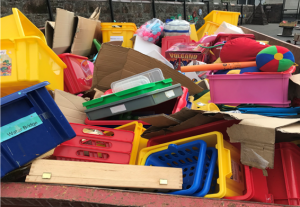 In this snapshot from a nursery in South Ayrshire, after they cleared out their plastic toys, a whole skip’s worth of mostly plastic materials was removed and, of course, recycled.
In this snapshot from a nursery in South Ayrshire, after they cleared out their plastic toys, a whole skip’s worth of mostly plastic materials was removed and, of course, recycled.
From existing examples of outdoor early years settings, we know that children do not need a lot of plastic, often specific-use, toys to have fun. A stick found in the woods can be a magic wand and a fallen log can be a fairy kingdom. Loose parts play – the use of recycled and reclaimed junk often made from natural materials – is a rewarding and enriching play experience for children. An outdoor space with bits of wood, old rope, tires and barrels allows children the joy of creativity, imagination and invention in their play. But it can also teach them about materials, their usefulness and what happens when they have been used. The things our children play with can spark a conversation with them about how the materials we use, and how we use them, affects our environment.
The world we live in belongs to our children. The parks, gardens, woodlands, hillsides, meadows, beaches and all the little patches of grass in Scotland belong to them. We must take immediate action on combating climate change. But we must also take our children outside to play in and enjoy their natural world to ensure they look after the Earth for their children a lot better than we have done for them.
Rachel Cowper is the Programme Lead for Thrive Outdoors. Find out more about our work here.
Celia Tennant on the benefits of outdoor play for Holyrood Magazine
Scotland is beautiful.
We have mountains and rolling hills, forests, meadows, sandy beaches and rocky bays. Our cities, towns and villages are rich with urban beauty too. In fact, with their abundance of parks and gardens, they are the greenest in the UK. It is a beautiful place to call home and should be a brilliant place to grow up.
But for many children like Kirsty, the Holyrood baby, now aged three, their experience of Scotland’s greenspace is all too limited. When it could and should be daily, for every single child.
Being outdoors is much more than an aesthetic joy. There are countless benefits that come from playing and learning outside, both for the individual and the wider world. Experiences of being outside – whether in rural or urban greenspace – will improve Kirsty’s physical and mental health, her ability and willingness to learn, and her social and emotional development.
It will spark her curiosity and equip her with the problem-solving skills she needs to become a scientist or engineer. It will help her think creatively and develop her imagination which she can use to be an artist, a musician, a chef or anything else she wants to be when she grows up.
Climbing trees and bounding down hills, she will learn to assess risk and danger and test her capabilities. It will help her to grow strong and learn physical skills that will stay with her for life. She could be a world class athlete or an avid amateur hill walker because of things she learnt playing outside when she was wee.
Playing outside will help her make friends and learn the social skills she will need throughout her life. It will give her confidence and self-esteem to rise to the challenges she will face in life, as well as the resilience to bounce back from disappointment and failure. All this while having fun, too.
These are things we all want for every child. They are things we all want for our future; opportunities for everyone in a healthy, happy society. But Kirsty and her generation’s opportunity to play outside is also vital if we want to have a future at all.
Playing and learning outdoors will cultivate in her an understanding and enjoyment of the natural world. As we learn more and more about the devastating effect climate change will have on our planet, it is imperative that we foster in each other the desire and the will to protect the environment. This must begin in childhood.
As part of Scotland’s Outdoor Play and Learning Coalition, we are working alongside nearly 90 organisations and individuals, from charities and councils to academics and healthcare professionals, to make sure that children like Kirsty have regular access to high-quality outdoor spaces, regardless of where they live or their family circumstances. There are many ways to do this.
Kirsty is now at nursery-going age and Scottish Government’s commitment to expanding free childcare hours for every child is an opportunity to make early years education an outdoors activity across the country by utilising under-used outdoor spaces.
Thinking about, caring for, and exploring the natural world can be embedded in everyday life at school, in the community and at home simply by making and taking the time to go outside and play. This shared activity creates a common purpose in all of us – to understand the world that nourishes us, and to nourish it in return.
The benefits of embracing outdoor play are vast, and the cost of not doing it is even greater. To deny our children a meaningful connection to the environment is to condemn them to ill-health, isolation, and impaired social and cognitive development. It is to deny them a chance to be part of a better future. It is also to deny our children the chance to enjoy the diversity of our beautiful world before it is too late.
We cannot let that be Kirsty’s future.
This piece originally featured in Holyrood magazine online on 23 May
There is so much to play for when we encourage young children to enjoy the outdoors
By Juliet Robertson, Outdoor learning and play specialist, Creative STAR Learning
The image of children splashing in muddy puddles or running, carefree through the woods, giggling in the way only happy children can, might seem like a nostalgic rural idyll to city dwellers in this age of social media and easy-access tech. But it doesn’t have to be.
John Swinney, the Cabinet Secretary for Education, has visited a new model of outdoor nursery that aims to make playing outside in nature part of the way children learn and develop from an early age, right in the heart of Glasgow. The project in Castlemilk is one of three providing outdoor childcare in the city set up by Glasgow City Council and the charity Inspiring Scotland.
They show that getting children outside to play is easy, no matter where you live. It is not just fun or nice to do. It is vital for children’s development.
There is a significant body of research and evidence from around the world that shows outdoor play in the natural environment allows children to thrive and grow in the best possible way.
There are obvious benefits such as increased physical activity which promotes better physical health and wellbeing, but outdoor play is so much more; it is the perfect learning environment.
When children are outside in nature they are exploring and discovering constantly; picking up leaves and twigs or gazing at a caterpillar or squirrel. This engenders a curiosity and willingness to learn that can last a lifetime.
It also helps children to connect with and understand their natural world in these times of accelerating climate change.
Outdoor play and learning can also promote wider mental development in children. Evidence points to outdoor play-based learning helping young children to focus and concentrate more, leading to better educational performance. Being outside in nature has an inherent freedom too; a freedom to run and splash and climb and roll around but also to imagine and create. When children are allowed the freedom to play outside they can turn a stick into a magic wand or a pile of leaves into a secret den.
Let’s not forget that playing outside is fun; children are happy when they play outside. Running and jumping, falling over and getting back up again helps children to build emotional and physical resilience and learn how to manage and assess risk as well as understand their capabilities.
Play is how children socialise, develop empathy and collaboration, simply by taking turns.
With so much green space available, even in the heart of our biggest city, Scotland is in a position to develop a world-leading outdoor learning environment, nurturing our children to become healthy, happy, curious and creative, well-rounded citizens and custodians of our natural world.
What’s more, outdoor play and learning need not be limited to nursery or school time, or even to weekends. There are so many opportunities for families to get out and play and explore their local places.
I am delighted to see Inspiring Scotland is also working with the Scottish Government in a campaign called #AwayandPlay to encourage more outdoor play for everyone.
Getting outside to play with our children (grandchildren, nieces, nephews, friends, neighbours) is easy and, with undeniable benefits, is it not our obligation too?
I am passionate about motivating people to get children outside. But we all have a responsibility, whether as parents or policymakers, to encourage our children to be healthy, free, rounded and grounded through play. So what are you waiting for? Away and play outside.
This article originally appeared in The Herald 11/12/17

